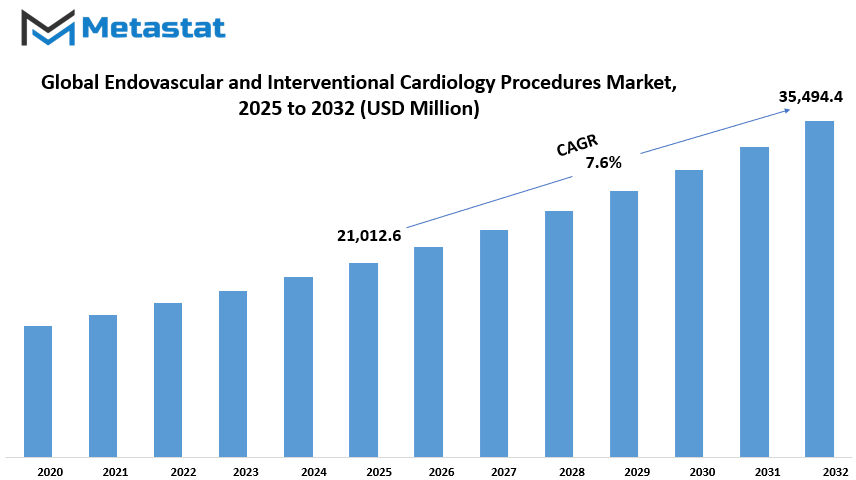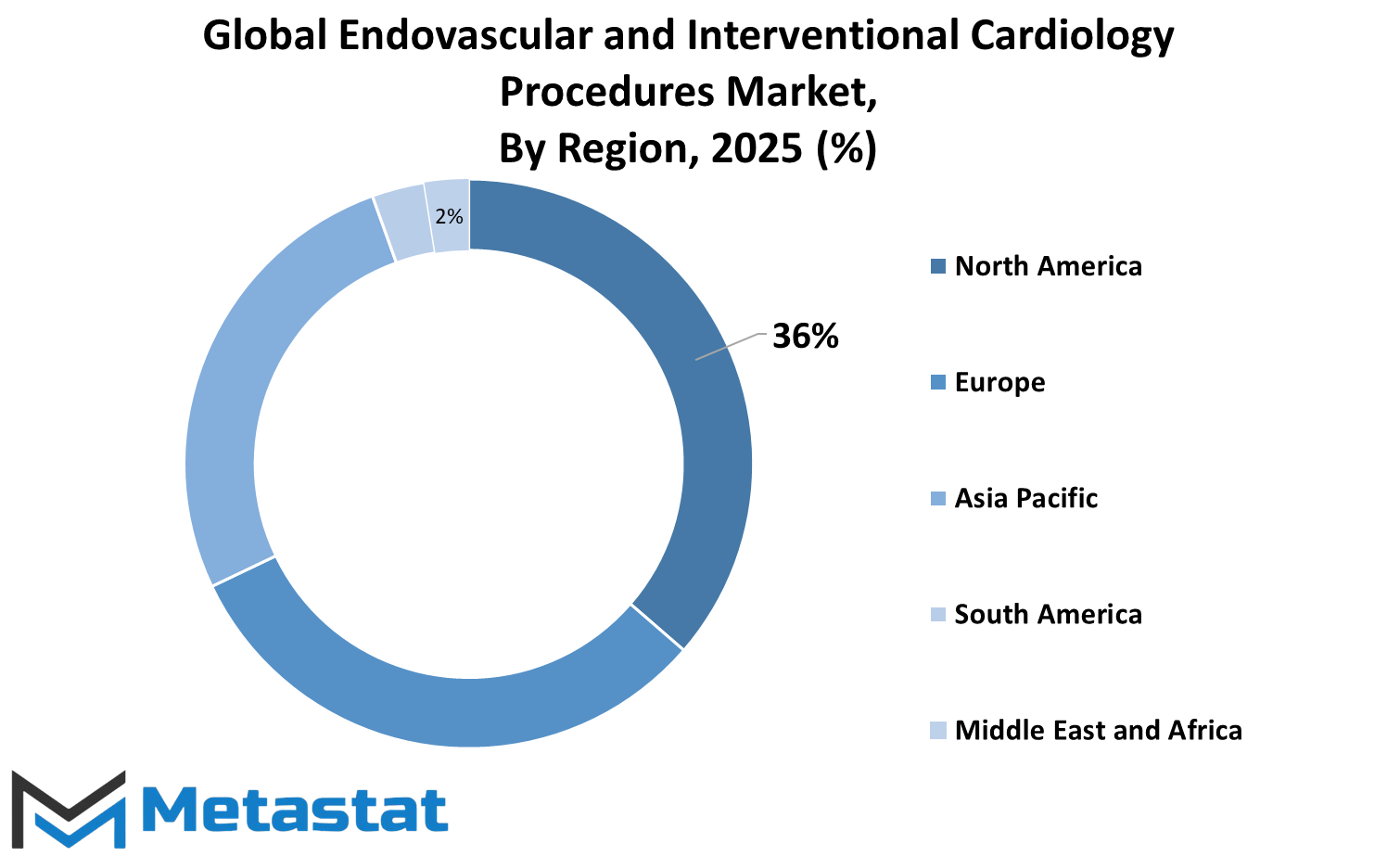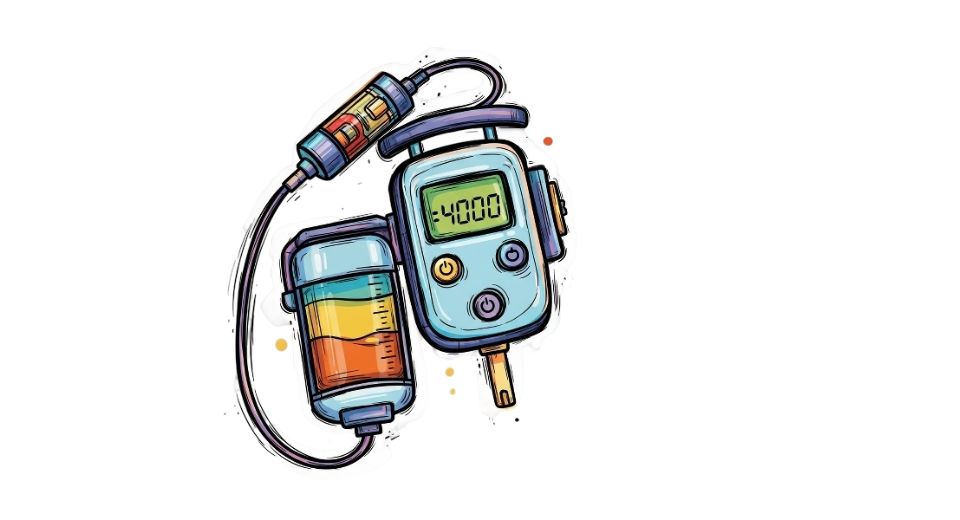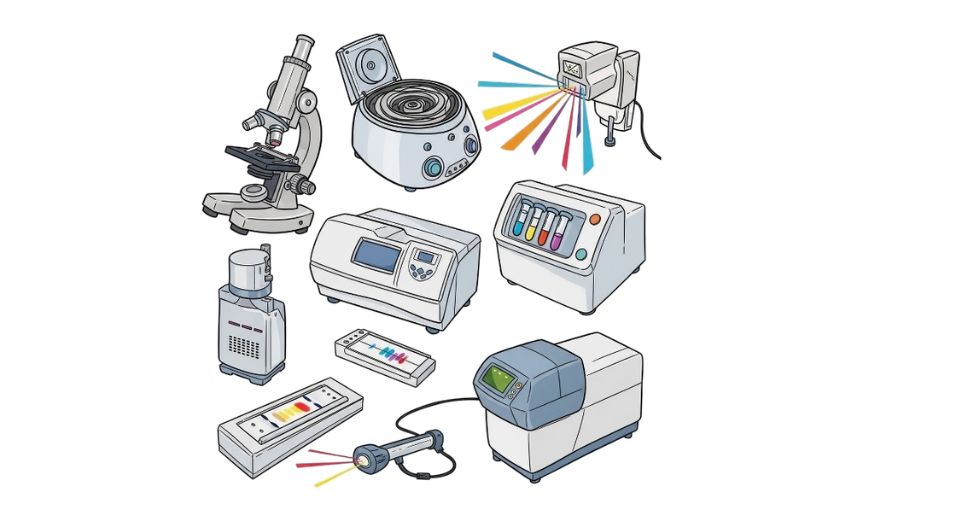MARKET OVERVIEW
The global endovascular and interventional cardiology procedures market will move beyond the conventional limits normally conceived by most analysts and stakeholders. Although the market is normally regarded as only a department dedicated to minimally invasive cardiovascular disease treatment, its future will come in forms that marry technological advancements, healthcare policy reform, and shifting patient populations in unprecedented ways.
One of the areas outside the current horizon will be the integration of new imaging technologies with endovascular intervention. New technologies like real-time 3D imaging and augmented reality-based interventions will revolutionize the way in which complex vascular anatomy is tackled by cardiologists. These advancements will not only optimize intervention precision but will also enable procedures to be extended to cases that were previously thought to be too complex or risky. This will result in redescription of patient appropriateness and provide the potential to treat more varied forms of cardiovascular disease with greater success.
In addition, the combination of artificial intelligence and procedural planning will revolutionize this discipline. Predictive analytics and machine learning algorithms will be used to personalize interventions to suit each patient's profile, ensuring maximum benefit and obviating complications. The setting will evolve from one-size-fits-all to dramatically personalized care pathways, redefining the way cardiology procedures are conceived and conducted. This is likely to compel healthcare professionals to adapt quickly, and data-driven decision-making will become an intrinsic part of day-to-day clinical practice.
The global endovascular and interventional cardiology procedures market is a major concern ageing patient populations across different geographies will drive demand for less invasive procedures with faster recovery and fewer complications. Simultaneously, the increasing burden of lifestyle-related chronic diseases will create demand for newer interventional technologies capable of addressing complex comorbidities. The marketplace will need to respond not only to these demands but also by actively anticipating emerging clinical challenges in the future emanating from changing public health profiles globally.
The second aspect that will evolve beyond conventional wisdom includes regulatory environments and payment policies. Governments and healthcare organizations will play more attention to value-based care, compelling manufacturers and healthcare providers to prove not just clinical efficacy but cost-effectiveness of endovascular treatment as an option. This will propel the creation of next-generation devices and methods balancing innovation and price and making these life-saving interventions more affordable. It will propel the integration of intersectoral partnerships among medical technology, insurance, and policymaking expertise to create sustainable models of care.
Globalization of clinical trials and cross-border collaboration will also be a factor. Market expansion will involve more rapid transfer of knowledge and global guidelines, and thus newer treatments will reach diverse populations at a quicker rate. This will test prevailing paradigms that exist and require increased international collaboration between healthcare organizations, research centers, and industry participants to maintain standards and adoption of newer interventions at a quicker rate.
This will be coupled with a radical revolution in training and educational systems for interventional cardiologists. Virtual reality simulation and distant mentorship will be the norm, enabling practitioners in far-flung or underserved regions to achieve mastery without the limitations of the current training environment. Skill building leveling will enable the closure of the gap in access to healthcare, ultimately leading to more standard global distribution of advanced cardiovascular care.
Overall, the global endovascular and interventional cardiology procedures market will exceed expectations by adopting technological convergence, personalized medicine, demographic changes, changing regulatory requirements, global collaboration, and innovative education models. All these changes collectively will transform the industry, expanding its scope and potential for change in ways that will remake cardiovascular care globally.
Global endovascular and interventional cardiology procedures market is estimated to reach $35,494.4 Million by 2032; growing at a CAGR of 7.6% from 2025 to 2032.

GROWTH FACTORS
The global endovascular and interventional cardiology procedures market is continuously increasing due to various types of major reasons. The major driving force is the increasing number of patients affected by heart disease. Since health issues in relation to the heart are increasing, the demand for minimum invasive processes is increasing. Through the use of Endovascular and interventional cardiology therapy, small catheters and imaging techniques, less risk and low recovery time patients offer avenue to treat patients with low recovery time. This movement towards minimum invasive therapy is encouraging the increasing use of these treatments by doctors, leading to the market.
Another important inspiration to run the market is technological progress. New and more advanced imaging equipment and catheter equipment make doctors convenient to do these procedures safe and efficiently. With advanced technology, the success rate of treatment increases, and more patients are able to take advantage of themselves. These developments also enable the hospital's stay and low risk of complications, which make these options attractive to patients as well as medical physicians.
Despite these positive factors, there are challenges to the market. Among the greatest challenges is that procedures and devices are expensive. Many devices used in endovascular cardiology are expensive to produce and make. This elevated cost is bound to hamper access to the procedures, especially in poorer regions where the health budget is modest. As a result, many patients residing in poorer areas may not have access to such new procedures even if they need them. In addition, stringent clearance regulations for new devices and insurance reimbursement issues make it difficult for companies to bring new products into the market as well as patients getting access to them. All these regulatory and economic limitations hinder market expansion.
There are still prospects that can widen the market, though. Healthcare in most developing countries is growing with an upgrade in new hospitals, medical programs, and clinics. The growth in healthcare facilities results in more patients undergoing advanced cardiology treatment, creating new demand. The world is also aging, and aging people are likely to undergo heart treatment. This increase in older patients will also lead to a greater need for interventional cardiology procedures in the years to come. All these elements indicate a bright future for the global market for endovascular and interventional cardiology procedures.
MARKET SEGMENTATION
By Type
The global endovascular and interventional cardiology procedures market is segmented into various huge categories, which are crucial in the treatment of each distinct heart conditions. Of these categories, the angioplasty takes the center stage, with a market value of $ 5,161.5 million. The procedure entails the enhancement of blood circulation and the opening of constricted or clogged blood vessels in order to lower the chances of heart attack or stroke. Angioplasty is now a routine and successful form of treatment, which allows many patients to escape more severe surgery.
Aside from angioplasty, the market includes the atherectomy, which is employed to evacuate plaque from vessels. This serves to purify the blockages and reinstate normal circulation. Embolization is another crucial procedure, whose intention is to occlude circulation into abnormal structures like aneurism or tumor, thus avoiding further complications. Thrombectomy is another form, whose function is eliminating blood clots, which can lead to severe complications like stroke or heart attack.
Stenting is another significant process in this market. This is the insertion of a tiny mesh tube within the blood vessels in order to maintain them open following angioplasty or other treatments. This assists in ensuring that there is healthy circulation and minimizing the risk of re -blocking. Catheter ablation and cardiac ablation are the procedures intended to correct abnormal heart rhythms by eliminating small portions of the heart tissue which results in abnormal heartbeat.
Endovascular aneurysm repair, also referred to as Eve, is a minimally invasive procedure for fixing weakened sections of blood vessels called aneurism. The treatment minimizes the risk of rupture and major bleeding. Peripheral vascular intervention corrects blood flow issues in arteries other than those in the heart, usually alleviates pain and tiredness from inadequate circulation.
Last but not least, carotid artery stenting is a procedure aimed at opening up narrowing in carotid arteries, which supplies oxygenated blood to the brain. This prevents stroke by keeping the arteries open.
Combined, these procedures have a broad scope of treatment in order to enhance heart and blood vessel health. The market continues to grow for these forms as technology improves and additional patients reap the rewards of less invasive methods. This enables many to receive successful care with minimal recovery and enhanced outcomes.
By Application
The global endovascular and interventional cardiology procedures market is a wide range of remedies used for the treatment of heart and vascular diseases. Depending on the applications of these procedures, the market has been divided into several major medical issues such as coronary artery disease (CAD), peripheral artery disease (PAD), aortic arterial arteries, stroke, venous thromboembolism (VTE), structural heart disease and other issues.
Coronary artery disease (CAD) is one of the most common heart diseases worldwide and is a major proponent in this market. This occurs when the arteries that supply blood to the heart are compressed or blocked, causing chest pain, shortness of breath, or even a heart attack. Endovascular and interventional cardiology processes will be used to reopen blocked arteries, improve blood flow and prevent heart damage. They are less aggressive than traditional surgery and therefore the choice of most patients and physicians.
Peripheral artery disease (PAD) is a blood vessel disease outside the heart, usually in the feet. The pad leads to the obstruction or narrowing of the arteries and leads to the loss of cloudine and walking. In this case, Endovascular treatment will increase blood flow and reduce symptoms. These intervention provide access to pads with low cuts, increase recovery time and cut complications.
The aortic artery is another which will benefit from these minimum invasive therapy. This occurs when a section of the aorta, the largest artery of the body, becomes weak and balloons become. If untreated, it will break and potentially will cause dangerous bleeding for life. Endovascular repair is to insert a small tube called a stent graft inside the artery to support the weak area, which reduces the chances of rupture.
The sudden loss of brain function due to stroke, a stuffed or burst blood vessel is also included in this market. Endovascular techniques will be used to quickly remove clots and restore blood flow to the brain, which will improve the possibility of recovery.
The venous thrombombolism (VTE), deep vein thrombosis, and pulmonary embolism are a blood clot in the veins. The intervention treatment will safely eliminate or dissolve them. Structural heart disease covers problems with heart valves and walls. Minimum invasive procedures will repair defective valves and repair defects, which will reduce the need for open-mortar surgery.
Finally, there is a segment titled "other" which includes other heart and heart disorders that can be treated through Endovascular and interventional cardiology treatment. Overall, this market will continue to grow as these less aggressive techniques become more popular and are introduced worldwide.
By End User
The global endovascular and interventional cardiology procedures market is divided on the basis of the final-user type. Last users include hospitals, ambulatory surgical centers (ASCS), special clinics, cardiac catheterization laborators and research and educational institutions. All these areas are very important how these processes are conducted and how the market develops overall.
Hospital is the main section of this market as they provide complete treatment to patients who require Endovascular and interventional cardiology treatment. They have facilities, manpower and technology to treat various matters, which range from minor to complex. Most of these treatments are distributed in hospitals in hospitals due to the treatment of emergency conditions and the ability to provide follow -up care. The hospital, due to its size, stand to capture the largest part of market development.
Ambulance Surgical Center (ASCS) is gaining popularity as a place for low aggressive surgery. Centers offer patients to get treatment and are discharged on the same day, which is more convenient and is often less expensive than being inconsistent. ASCS helps reduce burden on hospitals and offers a cost -effective option for patients that require early recovery. ASCS will be expected to increase the development of the overall market in detail as it improves access to Endovascular and interventional cardiology treatments.
Special clinics are dedicated to heart related diseases. They are equipped with trained staff to conduct advanced machinery and various cardiology processes. Since they focus on heart welfare, they provide focus and follow -up to patients.
Cardiac catheterization laboratories, or cath labs are special partitions in hospitals or stand-alone features designed to diagnose and healing procedures for heart diseases. Laboratories use advanced technology to perform minimum invasive procedures that help in detecting and treating obstacles and other cardiovascular problems. The market relevance of Cath Labs is increasing with the increasing demand for less aggressive processes.
Research and educational institutions contribute to the traditional and Endovascular cardiology knowledge and techniques. Clinical trials are conducted, a new technology engineer, and healthcare workers are trained by these institutions. Their work contributes significantly in the market to improve the patient's care and innovation.
Together, all the end user segments contribute to the development and progress of global endovascular and interventional cardiology procedures market through different altitude but interconnected methods. Together, they lead the future of cardiac treatment worldwide.
|
Forecast Period |
2025-2032 |
|
Market Size in 2025 |
$21,012.6 million |
|
Market Size by 2032 |
$35,494.4 Million |
|
Growth Rate from 2025 to 2032 |
7.6% |
|
Base Year |
2024 |
|
Regions Covered |
North America, Europe, Asia-Pacific, South America, Middle East & Africa |
REGIONAL ANALYSIS
The global endovascular and interventional cardiology procedures market across the world is classified on the basis of various geographic regions. These regions are North America, Europe, Asia-Pacific, South America, and the Middle East & Africa. These regions are divided into individual countries or country groups to give a better view of the distribution of the market.
In North America, the market is segmented into the United States, Canada, and Mexico. These are the leading contributors to the market in this region, with the U.S. having the largest contribution because of its highly developed healthcare system and technological advancements in cardiology interventions. Canada and Mexico also make contributions, albeit smaller in scale, with expanding demand motivated by rising awareness and access to health care.
Europe's market is shared between the United Kingdom, Germany, France, Italy, and the Rest of Europe. All these nations contribute significantly, with Germany and the UK usually taking the lead due to their well-established healthcare systems and high rates of adoption of new cardiology procedures. France and Italy also share a great deal of contribution, while the Rest of Europe comprises other countries that are slowly building their share of this market.
Within the Asia-Pacific region, the market is divided into India, China, Japan, South Korea, and Rest of Asia-Pacific. China and Japan dominate here due to their massive populations and intense priority towards medical advancements. India and South Korea are significant ones as well, with expanding healthcare industries and increasing numbers of cardiovascular patients fueling demand. The Rest of Asia-Pacific includes other nations in the region where the market is growing steadily.
South America comprises Brazil, Argentina, and the Rest of South America. Brazil is the dominant market within the region due to advancements in healthcare access and infrastructure. Argentina also makes a contribution, while the Rest of South America consists of other nations trying to establish their cardiology services.
Lastly, the Middle East & Africa region is segmented into GCC Countries, Egypt, South Africa, and the Rest of Middle East & Africa. The GCC Countries, being with greater healthcare investments, dominate this region, followed by South Africa and Egypt, where increasing healthcare needs are driving the market ahead. The Rest of Middle East & Africa includes other nations with developing cardiology markets. This regional split illustrates where the demand for Endovascular and Interventional Cardiology Procedures is highest and its area of growth in the future.

COMPETITIVE PLAYERS
The global endovascular and interventional cardiology procedures market has experienced remarkable growth in recent years due to the improvement in medical technology and increased demand for minimally invasive therapies. All these procedures target the treatment of cardiovascular diseases through approaches that minimize the use of open surgery, hence shorter periods of recovery and less risk to patients. The industry is driven by a number of major players who have become leaders by providing innovative solutions and products that enhance patient outcomes and procedural effectiveness.
Among the biggest names in this sector is Medtronic plc, a well-established medical technology company that offers a broad portfolio of devices utilized in cardiac interventions. Boston Scientific Corporation is another significant industry participant, renowned for offering an extensive range of products that assist doctors in treating cardiovascular diseases with exactness. Biosensors International Group, Ltd. is another participant with specialized equipment intended to aid in vascular and cardiac procedures. Koninklijke Philips N.V. also pools its knowledge in imaging and diagnostic technology, which are essential for navigating these minimally invasive procedures.
Other significant firms are Terumo Corporation, supplying advanced instruments and equipment to aid in different endovascular procedures. Alvimedica specializes in cardiovascular product innovation, while Teleflex Incorporated provides medical devices that aid in interventional cardiology. ACIST Medical Systems offers technology that improves the precision and safety of the procedures. Translumina specializes in catheter technologies, and Abbott Laboratories provides a wide assortment of cardiovascular devices to diagnose and treat heart diseases.
Asahi Intecc Co., Ltd. and Integer Holdings Corporation complete the list of top firms by providing specialized equipment that facilitates interventional procedures. Each of these firms is important to the market in that they are constantly developing new technologies that enhance the safety, effectiveness, and accessibility of endovascular and interventional cardiology interventions.
The coordinated efforts of these players work towards developing the space, ensuring treatments are less invasive and more patient-centric. As cardiovascular diseases become more prevalent across the world, so will the demand for such procedures. That should encourage these companies to continue innovating and growing their offerings, enhancing competition and value for patients worldwide.
Endovascular and Interventional Cardiology Procedures Market Key Segments:
By Type
- Angioplasty
- Atherectomy
- Embolization
- Thrombectomy
- Stenting
- Catheter Ablation
- Cardiac Ablation
- Endovascular Aneurysm Repair (EVAR)
- Peripheral Vascular Intervention
- Carotid Artery Stenting
By Application
- Coronary Artery Disease (CAD)
- Peripheral Artery Disease (PAD)
- Aortic Aneurysm
- Stroke
- Venous Thromboembolism (VTE)
- Structural Heart Disease
- Others
By End User
- Hospitals
- Ambulatory Surgical Centers (ASCs)
- Specialty Clinics
- Cardiac Catheterization Laboratories
- Research and Academic Institutes
Key Global Endovascular and Interventional Cardiology Procedures Industry Players
- Medtronic plc
- Boston Scientific Corporation
- Biosensors International Group, Ltd.
- Koninklijke Philips N.V.
- Terumo Corporation
- Alvimedica
- Teleflex Incorporated
- ACIST Medical Systems
- Translumina
- Abbott Laboratories
- Asahi Intecc Co., Ltd.
- Integer Holdings Corporation
WHAT REPORT PROVIDES
- Full in-depth analysis of the parent Industry
- Important changes in market and its dynamics
- Segmentation details of the market
- Former, on-going, and projected market analysis in terms of volume and value
- Assessment of niche industry developments
- Market share analysis
- Key strategies of major players
- Emerging segments and regional growth potential








 US: +1 3023308252
US: +1 3023308252






